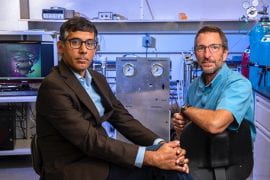Difference by the year 2100 expected to impact global biodiversity, food security
Latest News
Study: X-Rays Surrounding ‘Magnificent 7’ May Be Traces of Sought-After Particle
A new study, led by a theoretical physicist at Berkeley Lab, suggests that never-before-observed particles called axions may be the source of unexplained, high-energy X-ray emissions surrounding a group of neutron stars.
Building a Giant 2D Map of the Universe to Prepare for the Largest 3D Map
Before DESI, the Dark Energy Spectroscopic Instrument, can begin its 5-year mission from an Arizona mountaintop to produce the largest 3D sky map yet, researchers first needed an even bigger 2D map of the universe.
Shine On: Avalanching Nanoparticles Break Barriers to Imaging Cells in Real Time
A new material called “avalanching nanoparticles” co-designed by Berkeley Lab could lead to simple, high-resolution bioimaging in real time.
UCI Podcast: Running for city council as a 24-year-old PhD student
Dylan Green describes the challenges of seeking local elected office, and why more scientists should do so
UCI scientists measure local vibrational modes at individual crystalline faults
Breakthrough research made possible by advanced microscopic techniques
New Climate Change Study: Number of People Suffering Extreme Droughts Will Double
Michigan State University is leading a global research effort to offer the first worldwide view of how climate change could affect water availability and drought severity in the…
Nanomedicine Targets Cardiovascular Disease
Michigan State and Stanford researchers have upgraded their Trojan horse therapies designed to fight one of the world’s leading causes of death. Led by Bryan Smith, an associate…











